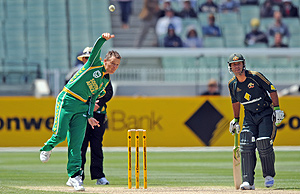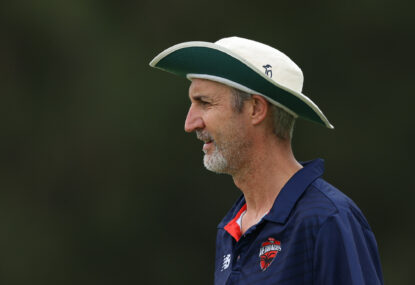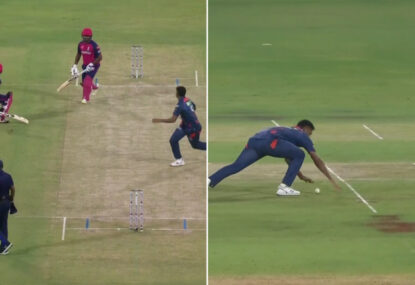
South Africa's Johan Botha bowls a delivery while Australia's Ricky Ponting looks on during their One Day International series match at the MCG in Melbourne, Friday, Jan. 16, 2009. AAP Image/Joe Castro
One Day Internationals have changed the way Test cricket is played, as various tactics and styles have crossed over into the longer form of the game. Twenty20 should have bought a whole wave of new innovations with it, focused on quickly changing tactics to suit the game situation.
But it seems captains and coaches are allowing the game to stagnate tactically.
Sambit Bal made a similar point in his excellent piece on Cricinfo noting that when South Africa needed someone to come in and make runs quickly against England, they toyed with the idea of a pinch hitter and then abandoned it, preferring not to deviate from “the plan”.
Bal’s point about the South African mentality playing a part in strictly adhering to “the plan” is correct, but at some point one must break away from national characteristics and do what is best for the team, regardless of which clichés it goes against.
If we look at the history of sport, those who changed first have invariably been successful.
And cricket is no exception.
Pakistan were probably the first really different team, becoming a force with Waqar and Wasim swinging the ball all-over, coupled with batting right down the order, they were able to score highly and take enough wickets to also win a World Cup.
In the mid-90s, Sri Lanka adapted and decided to deviate from the standard slow, podgy openers, instead opting for Jayasuria and Kaluwitharana, two extremely attack-minded players who slogged them to a World Cup.
Then four players helped to finally make a place for the art of spin bowling in ODIs.
Spinners had long been deemed surplus to requirements in the fifty over format, being either too expensive or unable to take wickets.
Warne, Muralitharan, Saqlain Mustaq and Anil Kumble placed a much higher value on field placements, devising plans for batsmen to restrict runs and frustrate players into giving away wickets in the crucial middle overs.
Warne’s 4/33 off 9 overs in the 1999 World Cup was one of the finest spells of his career, effectively spinning Australia to victory by way of his both attacking and run-saving bowling.
Fast bowlers also try to be inventive and have long attempted to perfect various deliveries: yorkers, throat-high bouncers, slower balls and cutters, bowling wide and narrow on the crease. Anything with a variation is deemed useful in ODI cricket as it unsettles batsmen.
So why is it that captains don’t see a situation and adjust the tactics in real time?
All teams go into a game with a plan, a batting line up, fields for certain players. But it seems when Plan A and B aren’t working, there is no Plan C and a reluctance to try something different.
Ba’s is the perfect example.
When South Africa needed someone to smash a few (they have a plenty of players suitable for the role) they sent in a solid, run accumulator until the required rate was unachievable, effectively throwing themselves out of the Champions Trophy.
Captains and coaches across the world need to begin to move forward with the tactical side of the game.
There is no reason to stick to a plan once it is failing.
If a team needs quick runs, change the batting order, if a wicket is needed, try a part-timer – no-one will be vilified and the chances of winning will be better.
So why not try it?
I’d like to see something a bit like the Dutch “total football” concept applied to cricket.
Players who can bat up and down the order (even if it’s only to slog a quick 25-30), who are athletic enough to field in most positions, and anyone playing international cricket should be good enough to field in the slips (yes, I’m looking at you, Monty Panesar).
Specialist bowlers are always going to be needed, but there is no reason someone like a Ricky Ponting or Michael Hussey shouldn’t bowl an over or two per game, let alone Clarke, Katich and North, who should be afforded a lot more opportunities with the ball than they are.
By making the game more unpredictable, captains will better their odds, especially when their backs are against the wall.



































































































